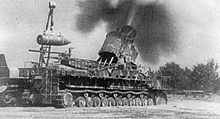Karl-Gerät: Difference between revisions
Lightmouse (talk | contribs) Script assisted. Units/dates/other |
→Usage: typo, german umlaut |
||
| Line 10: | Line 10: | ||
== Usage == |
== Usage == |
||
[[Image:Karl23.jpg|thumb|A section of three Mörser Karl in action in Poland in 1944. The ' |
[[Image:Karl23.jpg|thumb|A section of three Mörser Karl in action in Poland in 1944. The 'Munitionsträger' is shown on the extreme right. These mortars have the 540 mm tube fitted.]] |
||
At first the Mörser Karl was developed for use in the campaign against [[France]]'s [[Maginot line]], but as France had surrendered after the fortifications were bypassed, it was put to use for the first time on the [[Eastern Front]] against the [[Brest Fortress]] in 1941. It also saw action in the [[siege of Sevastopol]] in 1942. One mortar (''Ziu'') was employed against the [[Warsaw Uprising]] in 1944. |
At first the Mörser Karl was developed for use in the campaign against [[France]]'s [[Maginot line]], but as France had surrendered after the fortifications were bypassed, it was put to use for the first time on the [[Eastern Front]] against the [[Brest Fortress]] in 1941. It also saw action in the [[siege of Sevastopol]] in 1942. One mortar (''Ziu'') was employed against the [[Warsaw Uprising]] in 1944. |
||
Revision as of 08:06, 6 March 2008

Mörser „Karl“ (Gerät 040/041) was a series of 60 cm mortars designed to bombard heavily fortified positions. They were built in Germany during the Second World War.
History
The Karl (Gerät 040) series of mortars were built by Rheinmetall just before and during the Second World War, designed to take out heavily fortified positions. The 124 ton vehicle was self-propelled for short distances on its tracks, but this mode was mostly used for aiming (the mount had only 8 degrees of traverse) as the engines provided only 10 km/h speed for huge fuel consumption. The mortar was moved longer distances via a rail mount; transport was done by hanging the whole chassis between two huge railway bogies.
In total, six Karl-class guns were manufactured. These guns had the names Adam, Eva (1st Batt.), Thor, Odin (2nd Batt.), Loki, and Ziu. The self-propelled version of the 60 cm siege mortar was ordered in June 1937. General Karl Becker (general) of the Artillery was involved in the development, (explaining where the huge mortar gained its nickname). The driving trials were held at Unterlüss in May 1940. Delivery of the six production vehicles took place from November 1940 to August 1941. In February 1941, discussions commenced concerning increasing the range of the weapon, and in May 1942, 54 cm barrels (Gerät 041) were ordered for the six vehicles. At a conference with Hitler in March 1943 it was stated that the first 54 cm Gerät 041 would be delivered by June 1943, and the third, by mid-August. The 60 cm and 54 cm barrels appear to have been interchanged as required.
Usage

At first the Mörser Karl was developed for use in the campaign against France's Maginot line, but as France had surrendered after the fortifications were bypassed, it was put to use for the first time on the Eastern Front against the Brest Fortress in 1941. It also saw action in the siege of Sevastopol in 1942. One mortar (Ziu) was employed against the Warsaw Uprising in 1944.
The 60 cm Mörser Karl had a range of 6800 m (4.22 miles) at best. To put this in perspective, this is about one-third the range of a typical 105 mm/122 mm howitzer of the same era, and is closer in performance to the Infantry's heavy mortars. To extend the range, a gun barrel of 54 cm calibre and 7.1 m in length was manufactured. Three Karls were equipped with it instead of the 60 cm calibre gun to become the 54 cm Mörser, designated Gerät 041, with a longer range of 10,400 m. The ammunition for these guns weighed about 2 tons each depending on the specific ammunition type. The guns usually worked in pairs. Thirteen modified Panzer IV chassis vehicles were outfitted with special cranes as 'Munitionsträger' support loaders, two for each weapon with one extra.
Due to its huge size and concomitant difficulty of use, its effect on the outcome of the war was minimal. Given the very short range and need to deploy close to a railway, it is probable that these weapons were envisioned for use on a relatively static front, such as an assault on the Maginot Line or other major fortifications.
Fate

In 1945, "Karl II (Eva)" as well as "Karl V (Loki)" were captured by US forces in the period 21 March to 11 April 1945. No. VI was captured by the Red Army, probably at Jueterborg on 20 April 1945. This is on display at Kubinka.
No.IV was captured by the Red Army. No.VII (experimental chassis) was captured by the US Army in Hillersleben and later shipped to Aberdeen Proving Grounds but later scrapped.
The fate of guns No.I and No.III are not known. It is possible both were captured by the Red Army in Jueterborg.
Literature
- Gerhard Taube: Die schwersten Steilfeuer–Geschütze 1914 - 1945. Geheimwaffen 'Dicke Berta' und 'Karl', Motorbuch-Verlag, ISBN 3-87943-811-0
